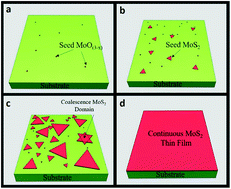Promoter-free synthesis of monolayer MoS2 by chemical vapour deposition†
Abstract
Molybdenum disulphide (MoS2), a graphene analogue, is emerging as an exciting material for future nanoelectronics due to its unique electronic transport properties. Here we report the large-scale and homogeneous synthesis of a high quality MoS2 monolayer directly onto SiO2 substrate by a facile seed promoter-free chemical vapour deposition (CVD) process. A piranha treatment process favourably reduces the surface free energy of the substrate for the incoming growth species to nucleate, thus paving a way for controlled layered growth via a Frank–van der Merve growth mode. A classical nucleation theory is explored to understand the layered and particle growth of MoS2 with and without piranha treatment, respectively. By carefully tracking the piranha treatment and sulphurization time, the coverage of the MoS2 monolayer can be extended to a centimeter scale with highly reproducible features. The electrocatalytic hydrogen evolution reaction (HER) using large-scale MoS2 demonstrates excellent properties, with a turn-on potential of 0.15 V vs. RHE and a Tafel slope of 46 mV dec−1. Our results confirm that piranha treatment provides an ideal platform for the controlled growth of large-scale monolayer MoS2 on dielectric and semiconductor substrates, such as SiO2 and Si, for device applications.



 Please wait while we load your content...
Please wait while we load your content...